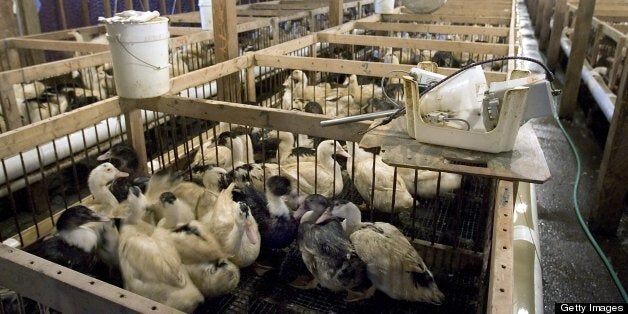
In semi-darkness, crammed in individual cages, heads out one end and tails the other, the ducklings have no room to move let alone stretch their wings. Their feathers are curled and sticky and their eyes gunged up with dirt.
The birds are now 8 - 10 weeks old and this is the final stage of the foie gras production process. It will last 3 to 4 weeks. Twice daily a 12cm diameter metal tube is put down their throats and a slurry of corn mash, oil, water and salt is pressed down into their stomachs. The process is called gavage: force-feeding. It takes just a couple of seconds to feed each bird and a single operator can force-feed more than 1000 in one hour.
Already the birds' livers have been enlarged by a high starch diet. But force-feeding speeds up the process until the livers have grown to 6 to 10 times their normal size. The birds have become clinically ill with a liver disease called hepatic lipidosis or fatty-liver disease (foie gras means fat liver in French). In humans the disease causes great pain that can only be relieved by draining accumulated fluid from the abdomen.
As the birds' livers become ever more distended their abdomens balloon and they have difficulty breathing. Their windpipes become so thickened; inflamed; bruised; and infected that they would be unable to eat of their own accord. Acute enteritis (which inflames intestines and causes diarrhoea) is common. And so are haemorrhages and jaundice.
One in five of these birds die prematurely. The most common causes are cardiac and renal failure and liver haemorrhage. Some are killed when their stomachs split during the gavage process.
Post-mortems in slaughterhouses have shown that 30% to 70% have suffered severe injuries: bruised and broken bills; damaged throat muscles; maggot-infested neck wounds; multiple broken bones including wing fractures (the last attributed to a diet deficient in calcium).
Traditionally foie gras was produced from geese but ducks are preferred for intensive production because they are cheaper to feed - and as a consequence mass production increases.
The French are both the largest producers and consumers of foie gras which they claim to be part of their national heritage. Other foie gras producing countries are Belgium, Bulgaria, Canada (in Quebec), China, Hungary, Spain and the USA. Although production has been banned in the EU an exemption was made for countries that had an existing trade. Hence its ban in the UK - but not its import. In the United States production has been banned in California and the city of Chicago has forbidden selling it. Production has also been prohibited in Argentina, Israel and Switzerland.
A number of well-known people have spoken out against the terrible cruelty involved in gavage-based foie gras. Among them are HRH Prince Charles (who does not permit foie gras on Royal menus), Paul McCartney, Joanna Lumley, Sir Roger Moore, Kate Winslet, Martin Sheen, Kim Bassinger and Pope Benedict XVI (when he was a cardinal). However Pope Francis - despite choosing his name in honour of the patron saint of animals - seems not to have spoken on animal matters at all.
Most celebrity chefs also seem to avoid commenting. The exceptions are Albert Roux, the US's Wolfgang Puck and, in the UK, Hugh Fearnley-Whittingstall. The latter has spoken against the barbaric methods of intensive production but not, he says, production on a small artisan scale since he witnessed birds willingly coming to be fed - gently and calmly - with a funnel. But this type of production is very much in the minority and the overwhelming majority of foie gras production is on an industrial scale.
In the UK several well known venues have also taken a stand and refuse to serve foie gras: the House of Commons; the House of Lords; the Royal Shakespeare Company; Wimbledon; Lord's Cricket Ground. And Harvey Nichols, Selfridges and the House of Fraser refuse to sell it.
PETA (People for the Ethical Treatment of Animals) UK say they won't stop campaigning until they have added Fortnum & Mason to that list. They are just one of a considerable number of animal welfare groups that are pushing to have production banned - like the UK's Compassion in World Farming Trust and Viva!; Gourmet Cruelty in the US and Liberation BC in Canada.
Petitions are also adding weight to the campaign against foie gras production and its import into the UK ( www.epetitions.direct.gov.uk/petitions/42973 and
www.thepetitionsite.com/10/we-the-undersigned are two of them).
But despite such high profile and active denunciation foie gras is available in a raft of the UK's restaurants, delicatessens and on line - including from Harrods and Fortnum & Mason. For those who enjoy eating the diseased liver from a tortured animal there is no shortage of supply.